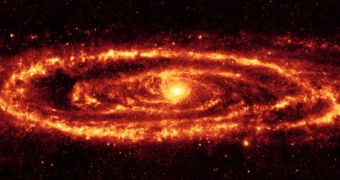UK astronomers took it upon themselves to create the most elaborate and complex map of the skies ever designed, one that will feature the formation of galaxies and their lives. This will be accomplished by using the Spitzer Extragalactic Representative Volume Survey (SERVS) Infrared Array Camera on NASA's Spitzer Space Telescope, which will be oriented towards a carefully-selected portion of the sky, and will take pictures on a complementary light wavelength, one that was never before used for such purposes.
In addition to this high-tech equipment, the team will also use overlapping photos from the Herschel and the SCUBA-2 observers, which will photograph the same areas of deep-space, but in different light wavelengths. By superimposing the resulted pictures on top of each other, researchers at the Spitzer Science Center at Caltech, led by Dr Mark Lacy, hope to be able to create an image that will give them a better understanding of how galaxies came to be, their history and their evolution up to this point.
"This mid-infrared survey fills a crucial gap in wavelength between the large near-infrared surveys being conducted by UK-based teams, and the far-infrared surveys to be conducted by Herschel and SCUBA-2. It will allow us to study the formation and evolution of massive galaxies like our own Milky Way in a truly representative volume of the Universe for the first time," Lacy says.
"This is likely to be the benchmark near-infrared survey for the next decade. The great depth of the SERVS data means we can detect moderately massive galaxies when the Universe was less than 8% of its current age. The combination of the SERVS data with data from the Herschel spacecraft (launch April 2009) also means we can see both relatively old, evolved stars, and young, dust-shrouded bursts of star formation. We will thus obtain a complete picture of how galaxies are assembled in the early Universe," adds University of Sussex expert Dr Duncan Farrah.
"The major improvement over past surveys is the combination of depth and area, allowing us to carry out these studies over both the densest and sparsest regions of the Universe. This will enable us to build up a picture of how galaxy formation and evolution is affected by the environment in which the galaxies reside," concludes University of Hertfordshire astronomer, Dr Matt Jarvis.

 14 DAY TRIAL //
14 DAY TRIAL //